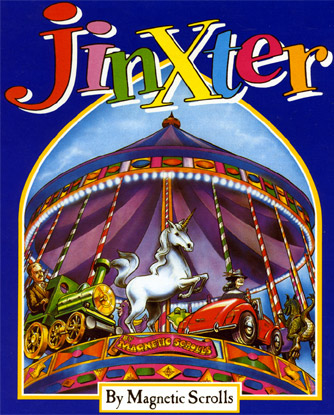|
'The
beautiful façade of Le Monaco restaurant beckons
you to take refuge from the streams of cars and buses
which rush past along London Road, swerving dangerously
close to the pedestrians as the road turns by the restaurant.
The only other place to find some seclusion is in the
park over the road to the west.'
At
a distance of half a mile or so from this upmarket Corruption
location in the City of London, south of the river between
London Bridge and Borough station, lie the offices of
Magnetic Scrolls. Nip down a grimy side alley, pass by
a hearty-looking London pub, travel up in a rickety, rattling
lift and you're there. It's a deceptively low profile
for a company that has won practically every adventure
accolade going including the prestigious British Micro
Computing Game of the Year award for The Guild of Thieves.
So
how did this small but successful company actually start?
We spoke to Ken Gordon and Anita Sinclair.
'When
the QL came out, that looked like an opportunity for writing
new, interesting games. When the ST came along with its
added graphics the move was easy because they're both
68000 machines. There was a gap in the market; nobody
had got into 16-bit machines so we took the chance.'
They
picked adventure rather than arcade games purely as a
matter of personal preference. The product of this initial
gamble was The Pawn. Set in the mythical land of
Kerovnia, it was marketed by Rainbird and converted to
run on a wide range of 16 and 8-bit formats ranging from
IBM PC compatibles to Amstrad CPCs.
Each
game takes about a year to develop. All primary work is
carried out on a huge DEC Micro Vax linked to a series
of individual terminals. With plenty of memory and disk
space it's associated with none of the initial problems
of working within the restrictions of a smaller machine.
Disks don't corrupt and valuable bits of information don't
get lost. A couple of programmers work from home on comparatively
fast Apricot Xens, but the bulk of the programming takes
place on a system which provides more than enough opportunity
to experiment.
|
|
|
What
amounts to about 80 % of a game is written by
two people, one specializing in the text and the
other in coding but as their work overlaps, neither
is a complete specialist.
About
two months before a game is due to be released,
work starts on the individual versions. A specific
format is assigned to each programmer: Ken, for
example, has been working on the Amiga version
of Corruption, Anita Sinclair on the ST.
Meanwhile a small army of play-testers and bug-spotters
is called into action.
Quality
Control
The
care that goes into the elaborate peripherals
reflects the potential shelf life of each product.
Ken Gordon:
'Our
idea of a nice product is not necessarily one
that's going to make number one in the charts
but one that's going to sell for years. We still
sell reasonable numbers of The Pawn.'
Ken
reckons that the games have been successful because
of the amount of effort that has been put into
them:
'If
we don't get something right it (the cause of
the bug) will either come out completely or we'll
delay things so it is right. We try and produce
the most high quality product we can. We aren't
in the same business as the people who sell their
products at £ 1.99.
|
|
|
It's
in the nature of an adventure that, in comparison
with top quality arcade products, it has a longer-lasting
shelf life.
'Adventure
games tend not to have as many bells and whistles
as, say, a 3-D shoot-'em-up which needs to have
features to appeal to the next generation of game
players. Adventures don't have the same initial
sales figures but new players are still buying comparatively
old adventures for the first time.'
GAC-Mania
Over
the years they've developed a whole range of in-house
adventure utilities. What do they think of some
of the finished systems available on the market
now?
'A
lot of really good ideas get strangled because a
system isn't capable of expressing them. One of
the most complex utilities available at the moment
lets you have up to 500 flags and 500 counters -
you couldn't express one of our games in those terms.
Without that extra flexibility, I could see it being
very difficult to write a half-reasonable game using
one of the adventure writing systems. The ones I've
seen, even by people I've expected to do quite well,
have been marginal.'
Magnetic
Scrolls adventures, on practically every format
other than the Spectrum, are well-known for their
excellent illustrations. So where does Ken really
stand in the great graphics versus text debate?
|
 |
|


